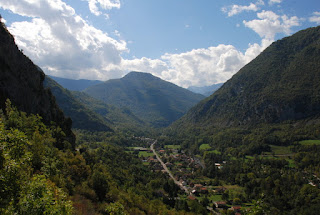Most surprisingly, we slept well despite the chimes and
walked across the road to get fresh bread at the boulangerie. We had to avoid
parking in part of the aire as the signs warned that there would be a market on
Tuesday morning. We needn’t have bothered as there were only two stalls but we
did buy some veg at one of them.
We set off east and drove through Foix, stopping on the
outskirts for some supermarket shopping. Then it was south on the main road
towards Andorra that rose slowly, surrounded by mountains. Our destination was
the ‘Grotte de Niaux’ one of the very few caves open to the public where it is
possible to see original prehistoric art. I had researched this on the Internet
before we left and also booked a tour in English of which there is only one per
day. The tour was at 13:30, so we arrived early so that we could have lunch
beforehand.
There are many caves in and around the Pyrenees and there
are two major caves on opposite sides of the river valley at Niaux – the Grotte
de Niaux and the Grotte de la Vache (discovered by a cow!). The theory is that
the painters of the art in the Niaux cave did not live at the entrance of that
cave but at the entrance of the Grotte de la Vache across the valley. No signs
of occupation have been found at Niaux but at La Vache, large amounts of
evidence have been found, although there is no art in those caves. Therefore
the thought is that the Niaux cave was considered ‘sacred’, a theory reinforced
by the fact that all of the art is deep in the cave, some more than 2 km in, a
very difficult and potentially dangerous journey. The art was painted in the
Magdelenian Period (18,500 to 10,500 BC) over a period of approximately 10,000
years between 13,850 and 12,850 BC. It consists of lines, dots and animals – mainly
bison and horses with a few ibex, one auroch and some fish. Unusually there are
also some engravings on the floors of the cave although we weren’t able to see
these. To protect the art, only a limited number of people are allowed into the
caves each day and the public are only allowed into the one gallery, the Salon
Noir, which is 800m into the cave and has 80% of the art that is in the caves.
Our guide, an archaeology graduate who had been giving tours of the cave for
seven years, was excellent – keen, very knowledgeable and very good English. For
most of our party English was not their first language, there were even some
French people despite the fact that only English was spoken. It made a huge
difference to have the whole talk in English rather than just short snippets
during a French language tour. The paintings, in black and red, were even
better than we expected. We have seen other cave art at Lascaux, Font de Gaume
and Altamira but this was exceptionally detailed and, in most cases, the animal
was clear without the need for any explanation. Like in many other caves, the
artists had often used the natural contours of the stone for parts of the
animals and it is thought that the features of the walls of the Salon Noir were
why it was chosen for so many paintings. An excellent tour and fantastic
paintings, well worth a visit.
We drove just over the other side of the valley to ‘Le
Camping des Grottes’ where we had the choice of almost all of the pitches. As
confirmation that we were in the mountains, the clouds built up over the peaks
and it started to rain.
Photos: View from the entrance to the Grotte de Niaux – our campsite
is at the bottom right; A picture taken a year after the “official discovery”
although graffiti still clearly visible in the cave shows that it was visited
as early as 1580; Map showing the layout and galleries of the cave.



No comments:
Post a Comment